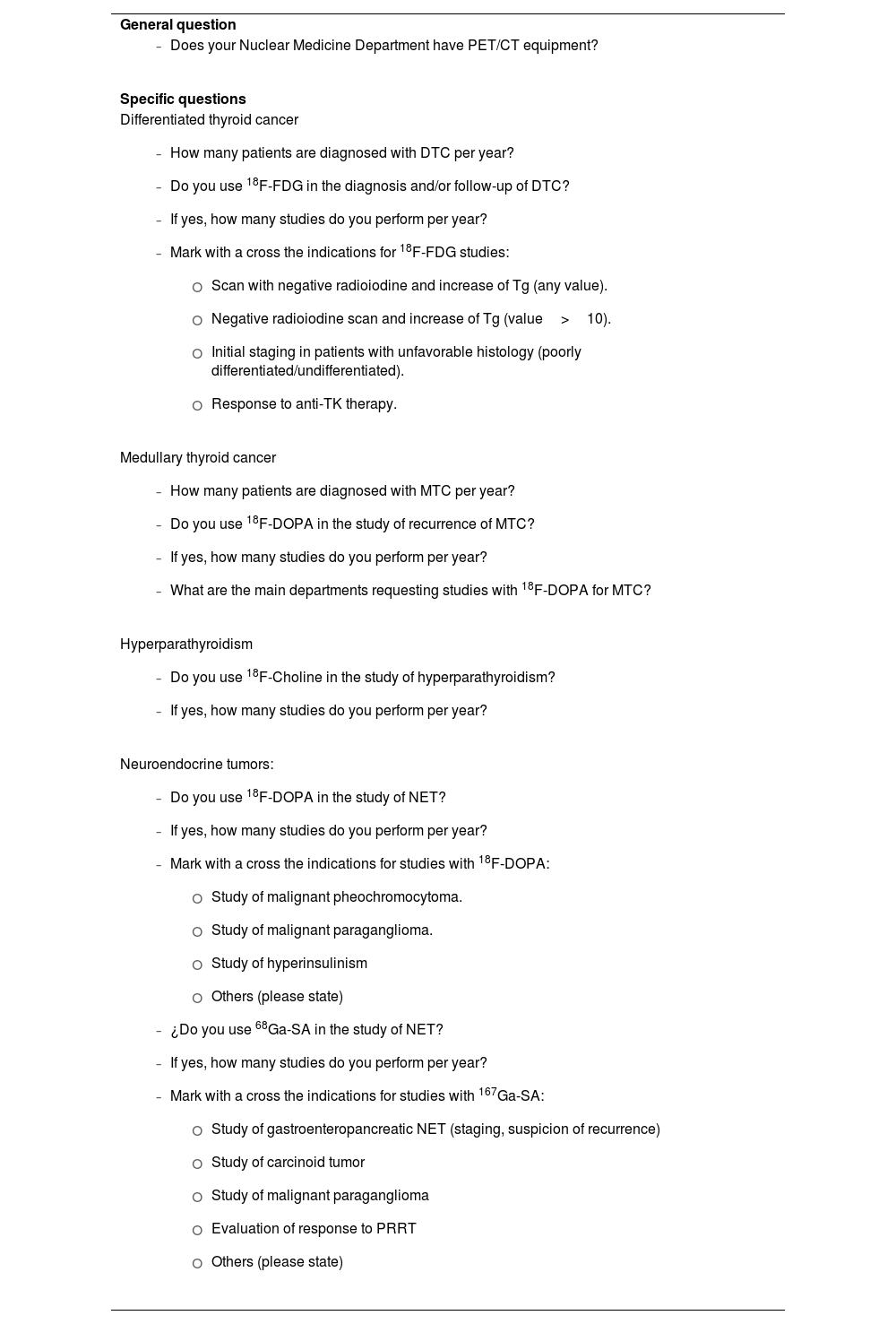To know the current use of the PET/CT technology applied in the field of endocrinology, the Endocrinology Working Group of SEMNIM proposed conducting a survey. The objective was to obtain a snapshot of the use of PET/CT in nuclear endocrinology, to know if it is being used properly and detect possible needs.
Material and methodsDuring the first quarter of 2022, we analyzed the data obtained from a survey that was distributed through different social networks throughout the second half of 2021. The survey asked for the use of the different PET/CT techniques available in Spain in different endocrinological pathologies like differentiated thyroid carcinoma, medullary thyroid carcinoma, neuroendocrine tumors and hyperparathyroidism.
ResultsA total of 15 centers responded to the survey. A percentage of 79 of hospitals used 18F-FDG PET/CT in the diagnosis and/or follow-up of differentiated thyroid carcinoma (mean annual studies: 36.9; range 10–100); 85% used 18F-DOPA PET/CT for the study of biochemical recurrence of medullary thyroid carcinoma (mean annual studies: 7.8; range 2–20); 77% used 18F-DOPA PET/CT for the study of neuroendocrine tumors: 77% used 18F-DOPA PET/CT (mean of 10 scans per year; range 2–30) and 69% used 68Ga-DOTA-SA (mean of 24.7 studies per year; range 2–127); 79% used 18F-choline PET/CT for the study of hyperparathyroidism (mean of 30.1 annual studies; range 10–120).
ConclusionsWe detected that the use of the PET/CT technique in endocrinology is not yet widespread, however, we saw that the indications in which it is used are, in general, those reported in the different consensus.
Desde el Grupo de Trabajo de Endocrinología de la SEMNIM, se planteó la necesidad de conocer el uso actual de la tecnología PET/TC aplicada en el campo de la endocrinología. El objetivo de la encuesta era obtener una fotografía instantánea del uso de la PET/TC en endocrinología nuclear, con el fin de conocer si está siendo adecuadamente utilizada y detectar posibles necesidades.
Material y métodosDurante el primer trimestre del 2022, se analizaron los datos obtenidos de una encuesta que se difundió a través de distintas redes sociales a lo largo de la segunda mitad del 2021. Se recogieron datos sobre el uso de las distintas técnicas PET/TC en el carcinoma diferenciado de tiroides, el carcinoma medular de tiroides, los tumores neuroendocrinos y el hiperparatiroidismo.
ResultadosUn total de 15 centros respondieron la encuesta. El 79% de los hospitales utilizan la 18F-FDG PET/TC en el diagnóstico y/o seguimiento del carcinoma diferenciado de tiroides (media de exploraciones anuales: 36,9; rango 10–100). El 85% utilizan la 18F-DOPA PET/TC para el estudio de recidiva bioquímica de carcinoma medular de tiroides (media estudios anuales: 7,8; rango 2–20). El 77% utilizan la 18F-DOPA PET/TC para el estudio de los tumores neuroendocrinos: el 77% utilizan la 18F-DOPA PET/TC (media de 10 exploraciones anuales; rango 2–30) y el 69% utilizan el 68Ga-DOTA-SA (media de 24,7 exploraciones anuales; rango 2–127). El 79% utilizan la 18F-colina PET/TC para el estudio del hiperparatiroidismo (media de 30,1 exploraciones anuales; rango 10–120).
ConclusionesEl uso de la técnica PET/TC en endocrinología aún no está generalizado, sin embargo, vimos que las indicaciones en las cuales se utiliza son, en general, las reportadas en los distintos consensos.
Article

Revista Española de Medicina Nuclear e Imagen Molecular (English Edition)











